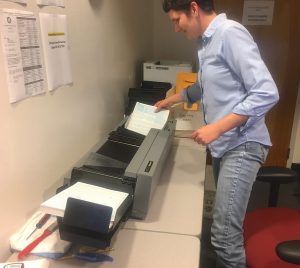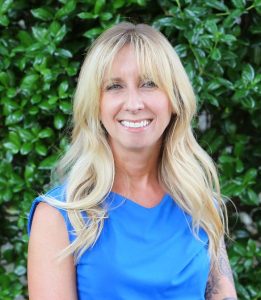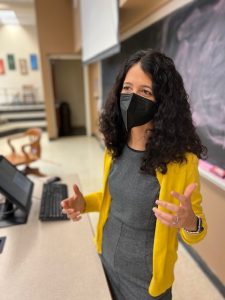On August 1, ITS will retire its exam scanning service, Digital Desk, marking the end of an era for centralized bubble sheet scanning.
The history of exam scanning at UNC-Chapel Hill has murky origins, but since at least the 1930s, instructors have brought bubble sheets to a central unit for automated scanning and processing.
Retiring Digital Desk does not mean the end of bubble sheets at Carolina. Instructors who wish to continue administering multiple choice tests on paper will transition to the self-service Gradescope platform. Gradescope also offers many advanced exam features.
Digital Desk’s brief history

Compared to the service it replaced, the outgoing Digital Desk has a short history at UNC-Chapel Hill. Deployed in 2017, Digital Desk replaced a homegrown scanning system supported by ITS for more than 35 years. At deployment, Digital Desk represented a leap forward in scanning speed and offered customized reports and integrations with ConnectCarolina. Instructors and other campus groups liked how easy it was to use. Students enjoyed being able view grades immediately after exams were processed.
Digital Desk exam scanning represents a collection of many parts, all managed by ITS Educational Technologies (EdTech). One of EdTech’s units — Educational Technologies Systems & Services, manages the database’s backend. Another EdTech unit, Classroom Hotline, supports a web frontend for instructors, an independent student grade portal and a client station for scanning exams.
Decision to retire

“We have not made this decision lightly,” Classroom Hotline Manager Gina Reitz said of retiring Digital Desk.
“As we look at the total exams that our office has scanned, we have seen a steady decline in scanning services usage over the past six years,” she said. “The total number of scanned exams has decreased from approximately 2,800 in 2016 to about 1,200 total exams scanned in 2019.”
Classrooms have slowly shifted from paper exams for years, but the COVID-19 pandemic and virtual instruction marked the most significant move away from centralized scanning services. With distributed populations, it was no longer practical for instructors to collect bubble sheets from students when alternative testing options were available.
Reducing costs
Retiring Digital Desk will reduce overhead for ITS. Digital Desk required EdTech to operate a physical scanning station on campus and provide in-person support. EdTech also needed to maintain backend and frontend applications for reporting. Streamlining operations aligns with the University strategic plan’s commitment to operational excellence, as outlined in the Carolina Next plan.
In addition to saving ITS staff time and resources, moving to Gradescope also streamlines exam scanning for faculty. With Digital Desk, instructors had to wait 24 hours for results. Gradescope provides results in an hour or less. Because Gradescope is self-service, instructors will have more control and flexibility on how they teach and administer tests and assignments.
Moving forward with Gradescope
The Gradescope platform, which replaces Digital Desk, has had a presence on campus since 2016. First adopted by STEM departments and later supported centrally by EdTech, Gradescope’s popularity swelled. Instructors touted the tool’s ease of use and advanced features, including their ability to use it for open-ended questions — something impossible with traditional bubble sheets.
“With the pandemic in full swing in 2020, instructors were faced with a dilemma of how to administer exams virtually and, again, we saw an increase in Gradescope adoption and even lower usage of Digital Desk,” Reitz said.
To make Gradescope successful at scale, EdTech collaborated internally to create technical solutions and end-user support for Gradescope. Gradescope is now integrated with both campus-supported learning management systems (LMS), Sakai and Canvas. These integrations enable instructors to sync rosters and grades between Gradescope and the LMS.
‘Game changer’

Gradescope continues to grow and add features, broadening its appeal to instructors. With Gradescope, instructors can administer online or paper-based exams and easily re-grade exams. They can also collaboratively grade with multiple instructors or teaching assistants in real time. The service also offers student performance tracking, electronic feedback delivery and statistics for both multiple-choice and open-ended questions.
“With Gradescope, I can mix free-response and multiple-choice questions and grade them all in one tool,” said Linda Green, Teaching Associate Professor in the Department of Mathematics. She can now avoid “the aggravation of having to merge scores from two different platforms.”
Kelly Hogan, STEM Teaching Professor at the Department of Biology and Associate Dean of Instructional Innovation in the College of Arts & Sciences, was an early adopter of Gradescope. “As I began using Gradescope, I immediately saw that it could do everything that our Digital Desk Scantron service could do and more,” she said.
Hogan was initially intrigued by the ability to go beyond multiple-choice questions. “I could use entirely new formats like AI-assisted grading around fill-in-the-blanks, short answers, drawings and more,” she said.
The tool is “a game changer with low and high stakes assessments for me teaching very large classes and a grading TA,” she added. “It could bring efficiency to better assessments in any size class.”
Paper bubble sheet lives on
Even in our increasingly virtual world, this is not the end for the paper bubble sheet. Gradescope will continue to support multiple choice paper exams for those nostalgic for classic Scantron sheets and the instructions to “make your mark heavy and dark.”
Instead of a pre-printed Scantron from Student Stores, students will use the Gradescope website to print a PDF bubble sheet. After their exam, students can use the Gradescope mobile app to photograph and upload the now-scanned exam. Students can also return a paper sheet to instructors for grading. Instructors scan the exam using a scanner attached to a computer or a combination printer/scanner that can generate PDF files. Next, the PDFs are uploaded to Gradescope for grading.
This system works especially well for hybrid instruction.
“Last semester I had a question on how to handle an in-person exam on Scantron while a few students were unable to attend,” said Abi Winegarden, Tech Support Specialist with Classroom Hotline. “The old system cannot read a photocopy, so there would be a delay to grade those late exams. With Gradescope, those students would be able to upload their own exam sheets directly into the system.”
Ongoing support

For instructors new to Gradescope, the program is intuitive, but there is a learning curve. EdTech recommends that instructors first use Gradescope for small assignments before using the tool to administer an exam.
“It did take me a little while to figure out that having students bubble in their answers, instead of circling a letter or writing in a letter, made it easier to use Gradescope’s auto-group features and grade multiple choice quickly,” Green said.
EdTech has curated information specific to Canvas and Sakai integrations, exam scanning replacement and frequently asked questions into one Gradescope support page. The page has garnered attention beyond Carolina.
“Just yesterday, Gradescope asked to reference our page in its communication to other institutions,” said Suzanne Cadwell, Director of Educational Technologies. Gradescope called it an “ideal resource page.”
Gradescope offers tremendous support through its website and training workshops. Instructors are invited to join the UNC Gradescope Teams site to share tips, ask questions and connect with fellow instructors using Gradescope.
For more information about Gradescope, visit the Gradescope support page. For answers about retiring Digital Desk and the transition to Gradescope, visit the FAQ page.
